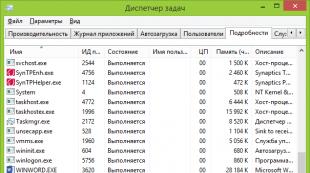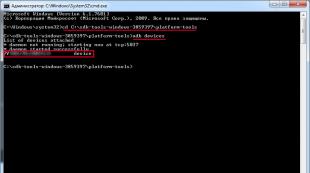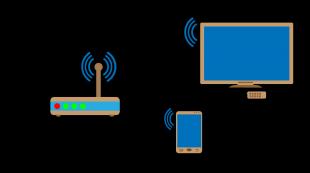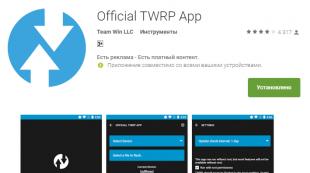A simple program for constructing circuits. Drawing and drawing electrical circuits online
Nowadays, every designer and programmer is faced with the construction of various kinds of diagrams and flowcharts. When information technology did not yet occupy such an important part of our lives, drawing these structures had to be done on a sheet of paper. Fortunately, all these steps are now performed using automated software installed on the user's computer.
On the Internet it is quite easy to find a huge number of editors that provide the ability to create, edit and export algorithmic and business graphics. However, it is not always easy to figure out which application is needed in a particular case.
Due to its versatility, the product from Microsoft can be useful both to professionals who have been building various structures for many years, and to ordinary users who need to draw a simple diagram.

Like any other program in the Microsoft Office series, Visio has all the tools necessary for comfortable work: creating, editing, connecting and changing additional properties of shapes. A special analysis of the already built system was also implemented.
Dia
In second place in this list, quite rightly, is Dia, which contains all the functions necessary for a modern user for constructing circuits. In addition, the editor is distributed free of charge, which simplifies its use for educational purposes.

A huge standard library of forms and connections, as well as unique capabilities not offered by modern analogues - this awaits the user when accessing Dia.
Flying Logic
If you are looking for software with which you can quickly and easily build the necessary circuit, then the Flying Logic program is exactly what you need. There is no cumbersome complex interface and a huge number of visual chart settings. One click - adding a new object, the second - creating a union with other blocks. You can also combine schema elements into groups.

Unlike its analogues, this editor does not have a large number of different forms and connections. Plus, it is possible to display additional information on blocks, which is described in detail in the review on our website.
BreezeTree Software FlowBreeze
FlowBreeze is not a separate program, but an independent module that connects to Microsoft Excel, making it much easier to develop diagrams, flowcharts and other infographics.

Of course, FlowBreeze is software mostly intended for professional designers and the like, who understand all the intricacies of the functionality and understand what they are paying money for. It will be extremely difficult for average users to understand the editor, especially considering the interface is in English.
Edraw MAX
Like the previous editor, Edraw MAX is a product for advanced users who are professionally involved in such activities. However, unlike FlowBreeze, it is a standalone software with countless features.

In terms of interface style and operation, Edraw is very similar to Microsoft Visio. It’s not for nothing that it is called the latter’s main competitor.
AFCE Algorithm Flowcharts Editor
This editor is one of the least common among those presented in this article. This is due to the fact that its developer - an ordinary teacher from Russia - completely abandoned the development. But his product is still in some demand today, since it is perfect for any schoolchild or student who is learning the basics of programming.

In addition to this, the program is completely free, and its interface is made exclusively in Russian.
FCEditor
The concept of the FCEditor program is radically different from others presented in this article. Firstly, the work occurs exclusively with algorithmic flowcharts, which are actively used in programming.

Secondly, FSEditor independently, automatically builds all structures. All the user needs is to import the finished source code in one of the available programming languages, and then export the code converted into a schema.
BlockShem
The BlockShem program, unfortunately, provides much fewer functions and conveniences for users. There is no automation of the process in any form. In Flowchart, the user must manually draw the shapes and then combine them. This editor is more of a graphical editor than an object editor intended for creating diagrams.

Unfortunately, the library of figures in this program is extremely poor.
As you can see, there is a large selection of software designed for creating flowcharts. Moreover, applications differ not only in the number of functions - some of them imply a fundamentally different operating principle, distinguishable from analogues. Therefore, it is difficult to advise which editor to use - everyone can choose exactly the product that they need.
Drawing electrical circuits and drawings becomes an easier process if this is done using special software. The programs provide a huge number of tools and functions that are ideal for the task. In this article we have selected a small list of representatives of such software. Let's take a look at them.
First, let's look at the Visio program from the well-known Microsoft company. Its main task is drawing vector graphics, and thanks to this there are no professional restrictions. Electricians can freely create circuits and drawings here using built-in tools.

There are a large number of different figures and objects. Linking them is done with just one click. Microsoft Visio also provides many settings for the appearance of the diagram, page, and supports the insertion of diagram images and additional drawings. A trial version of the program is available for download for free on the official website. We recommend that you familiarize yourself with it before purchasing the complete product.
Eagle
Now let's look at specialized software for electricians. Eagle has built-in libraries containing a large number of different circuit type templates. The new project also begins with the creation of a catalog, where all used objects and documents will be sorted and stored.

The editor is implemented quite conveniently. There is a basic set of tools that help you quickly draw the correct drawing manually. In the second editor, printed circuit boards are created. It differs from the first one in the presence of additional functions that would be incorrect to place in the circuit diagram editor. The Russian language is present, but not all information is translated, which may be a problem for certain users.
Dip Trace
Dip Trace is a collection of several editors and menus that perform various processes on electrical circuits. The transition to one of the available operating modes is carried out through the built-in launcher.

In the mode of working with circuitry, the main actions take place with the printed circuit board. Components are added and edited here. Parts are selected from a specific menu where a large number of objects are installed by default, but the user can create the element manually using a different operating mode.
1-2-3 Diagram
The “1-2-3 Diagram” has been developed specifically to select a suitable electrical panel enclosure in accordance with the installed components and the reliability of the protection. The creation of a new scheme occurs through a wizard; the user only needs to select the necessary parameters and enter certain values.

There is a graphical display of the diagram; it can be sent to print, but cannot be edited. Once the project has been created, the panel cover is selected. At the moment, “1-2-3 Scheme” is not supported by the developer, updates have been coming out for a long time and most likely there will be no more of them at all.
sPlan
sPlan is one of the simplest tools on our list. It provides only the tools and features you need, making the process of creating a diagram as simple as possible. The user only needs to add components, link them and send the board to print, having previously configured it.

In addition, there is a small component editor, useful for those who want to add their own element. Here you can create labels and edit points. When saving an object, you need to be careful that it does not replace the original in the library if it is not necessary.
Compass-3D
"Compass-3D" is professional software for creating various diagrams and drawings. This software not only supports work in a plane, but also allows you to create full-fledged 3D models. The user can save files in a variety of formats and later use them in other programs.

The interface is implemented conveniently and completely Russified, even beginners should quickly get used to it. There are a large number of tools that ensure fast and correct drawing of a diagram. You can download the trial version of Compass-3D on the official website of the developers completely free of charge.
Electrician
Our list ends with “Electrician” - a useful tool for those who often perform various electrical calculations. The program is equipped with more than twenty different formulas and algorithms, with the help of which calculations are carried out in the shortest possible time. The user is only required to fill in certain lines and tick the required parameters.

We have selected for you several programs that allow you to work with electrical circuits. They are all somewhat similar, but also have their own unique functions, thanks to which they become popular among a wide range of users.
Today I want to talk about a very interesting service that I came across on the Internet - this service for drawing electrical circuits, which is called Scheme-it. I liked the service because it allows me to draw an electrical circuit “on my knees,” that is, quickly. Below I have prepared a brief overview of this service.
Scheme-it is an online tool for drawing schematic and structural diagrams, electrical drawings, which allows you not only to create diagrams, but also by saving them on the server to provide open web links to your diagrams.
The service is available at http://www.digikey.com/schemeit.
The service includes a complete set of schematic symbols for constructing electrical circuits, as well as an integrated Digi-Key catalog that supports the insertion of product images and photographs.
The tool also includes an integrated list of elements (specification), with which you can select a specific radio element from the catalog and associate the parameters of the real element with the circuit element.
How to save, open and delete electrical diagrams in Scheme-it.
In order to save electrical circuits created in the program and subsequently open them from the Digi-Key server, you need to log in to the site using your login.
If you do not have an account with Digi-Key, then go through a simple registration procedure on the site through the window that opens when you enter the Digi-Key website on the page of the online program for drawing diagrams at http://www.digikey.com/schemeit.

Alternatively, click on the Login/Register button (in the upper right corner of the application) and create a new account.
![]()
Main menu of the program (Main)
The main menu consists of four blocks: Project, Output, Edit, History.
The "New" button creates a new project. If you have a project open with unsaved changes, the application will prompt you to save the changes before creating a new project.
The "Open" button shows a dialog box containing previously saved projects. The dialog box also contains a delete button that allows you to delete the project. Select the project you want to delete and then click the button Delete.
All of the above functions will be available to you after registering on the program website.
Output block.
The "Export" button allows you to export the current project as a *.png image file or as a PDF document.
The "Share" button allows you to create and publish a web link of your diagram. A web link contains a schematic image file within a web page and is viewable in a standard web browser. The link is open.
The "Print" button opens the diagram in a new window, which can be printed using the standard browser menu.
Edit block.
The “Cut” button cuts the selected diagram element to the clipboard.
“Copy” button - places the selected item on the clipboard.
The “Paste” button retrieves a previously copied element from the clipboard.
The “Delete” button removes the selected element from the diagram.
History block
The Back button takes you back one action.
“Forward” button goes to a previously performed operation.
Drawing diagrams using the Scheme-it program.
On the left side of the site, Scheme-it contains an extensive library of schematic and graphical symbols (SGS) for use in circuit and structural electrical diagrams, as well as in various drawings. To place these symbols on the diagram, click on the desired category, select the symbol family, then click on the symbol and drag it onto the diagram (using the left mouse button).

Thus, by sequentially moving the necessary elements and connecting them to each other, an electrical circuit is created.
To connect the terminals of the elements to each other, left-click on the selected terminal of the radio element and, without releasing the mouse, drag a line to the next element.

An example of drawing an electrical circuit of an amplifier using transistors.

To change the spatial orientation of objects on the electrical diagram, there is a tab. When you click on this tab, the following tools will become available to you:

Creation of custom conditional graphical displays and symbols of elements of eclectic schemes
Scheme-it allows you to create your own symbols. In category "Custom Symbol"(Custom Symbol) there are simple elements for creating your own symbols.

The simplest elements include the element body and the element leads (legs, contacts, etc.).
Circuit element body.
The body is needed to create the basis for the future conditional graphic element of the circuit. Case shapes include: rectangle, rounded rectangle and triangle. When you move a package onto a schematic, the element is automatically included in the schematic specification.
Element findings.
Using pins, the final appearance of the graphic element is created. Outputs can be connected from above, below, left, right.
To connect the corresponding pin, simply drag it onto the future diagram.
The leads can be moved along the corresponding side.
Connection of electrical circuit elements.
Scheme-it allows you to create three types of connections:
Pin-pin (pin-pin);
Lead-wire:
Wire-wire.
Connection type: “Output-output (contact-contact)”

To connect two terminals of radioelements, you need to left-click on the first terminal, move the cursor to the second terminal and left-click. To change the configuration of the connecting wire, click on it with the mouse and drag it to the desired location.
Lead-to-wire connection.

To connect the output of a circuit element to a wire, you need to left-click on the element's output, move the cursor to the required connection point on the wire and left-click a second time.
Connection type "Wire - wire".

To connect two wires, you need to click on the selected place of connection of the first wire, thereby creating the first connection, then click on the required place on the second wire to create the second connection.
Adding and editing the text of diagram elements.
Text properties.
When you add various elements to the diagram, some text notes appear next to them, such as designation, denomination, etc.
To change the properties of this text, you need to select this text mark (highlighted with a green dotted ribbon), go to the top menu to the “Font” tab. Next, in the “Font” tab, set the necessary text properties (color, font scale, style, alignment, wrapping).
Adding text to existing symbols.
You can add text to an existing symbol by double-clicking the left mouse button on the element's image. This will open a window "Component Properties", in which you can fill in the missing characteristics of this element.

Such as "designation", "Name", "face value" etc. Do not forget to check the boxes next to them to display these characteristics on the diagram.
List of elements (BOM manager)
The service for drawing online diagrams Scheme-it has a tool - a list of elements (specification), to which all the elements of the diagram with their properties are automatically added: designation, name, denomination, part number, description, etc.

When adding a new element to the diagram, the program automatically adds it to the list of elements.
To view the properties of a schematic element and its attributes, double-click on the selected element, after which the element properties window will open.
In this window you can change any attributes of the schema element.
On the right side of the Scheme-it diagramming program there is a panel that allows you to search the Digi-Key catalog.

This function is useful for viewing reference data for a specific radio element.

Advantages of the service:
- a fairly simple program interface (despite the English language);
- The service is a good opportunity to draw diagrams on someone else’s computer without installing special programs (it is enough to have the Internet);
- the ability to save schemes on the server;
- publishing open links to your diagrams located on the server;
- export to PNG image or PDF document;
Flaws:
- lack of Russian language interface and help (however, you can use the built-in translator in the browser!);
- the component library is not made according to domestic standards;
- the need to have a constant Internet connection for the service to work.
So, after working in the program I can do the following conclusions:
Quite an interesting service, although the library of circuit elements is not made according to GOST, there are interesting symbols and icons. I recommend using it for drawing small electrical circuits, if it is not possible to work with special programs for drawing circuits (for example, someone else’s computer, etc.). The available library is sufficient for drawing basic electronics circuits.
P.S: An option to use the service for drawing electrical circuits Scheme-it using the translator built into the browser

I suggest watching a detailed video on how to use the online service for drawing electrical circuits:
Let's start with the fact that the term electrical (principal) circuit is used in electronics by radio amateurs. This article will be useful to students, engineers and hobbyists.
But what to do when there are no resources and time? Various online services come to the rescue. It turns out that drawing a diagram online is easy. Such services for drawing diagrams, the so-called diagram editors, are created specifically to “simplify the life” of the developer and, of course, differ in both ease of use when creating a diagram and functionality. The same circuit drawing functions exist in many automatic circuit design systems.
How to understand such diversity and choose a service that suits your requirements? What to do when you are sitting at someone else’s computer and it does not have the necessary CAD programs? The main thing is to have an Internet connection.
So, on the Internet there are enough services for drawing those same diagrams and even simulating the operation of the schemes. There are only three really good ones, with a complete list of radioelements, 123D Circuits And . Let me tell you right away that they do not contain Russian, only English, perhaps Google Translate will help you.
123D Circuits — company project Autodesk Inc, the one who made everyone famous AutoCAD. 123D Circuits is tightly integrated Arduino(Arduino is a small board with its own processor and memory). By registering you get a full-fledged CAD editor which includes tools such as:
- online project simulator ()
- online circuit diagram editor ()

- online circuit board editor ()

- Another interesting feature of this project is that the circuit simulation includes a firmware code editor with a debugger ()

Also in 123D Circuits there is a whole database ( Libraries) radioelements and their UGO. All actions and results of work in this online editor are saved in your account on the cloud, there is also export to the program Gerber. Overall, the company presented a good product to users.
is a free tool for drawing diagrams. A very large list of capabilities of this service, starting with simple drawing and ending with exporting a diagram in .png and .pdf, sharing on social networks and direct printing. Having an account in SchemeIt, you can save an unfinished diagram and finish it at any time.
The editor itself looks like this:

The bottom line is this: a pretty good tool for quickly drawing a diagram and saving it in a graphic format, but it lacks several UGO radio elements.
— assembly and testing of circuits directly in the browser. This service is more aimed at testing the assembled circuit, because There are clearly not enough elements there, but in those that are there, you can specify various parameters, such as voltage and current, resistance and capacitance, etc. for accuracy during testing. Of course, there is also export to graphic formats, as well as saving the circuit if you have an account in CircuitLab.
The “laboratory” looks like this:

To summarize, I will say that this service does not have much that is found in conventional CAD programs, although in principle it will be able to show a dependence graph, but it all depends on the specific diagram. There are enough UGO elements, but there are more of them in SchemeIt.
So we tried to draw a diagram online:
We looked at three main services for drawing diagrams online; all the other services I googled simply use their database and API.
If you find something similar on the Internet, please let us know - the article will be added with an indication of your nickname. We are waiting for comments and see you!
The Gliffy online editor features a variety of shapes, styles, colors and formats available for a wide range of projects. The use of Flash technology allows you to quickly place diagrams on the screen using drag-n-drop. Individual parts can be easily deleted, just select them and press the "Delete" key on the keyboard.
The Gliffy editor offers the opportunity to collaborate on a project, just activate the plugin and send an invitation to like-minded people. You can share your diagrams with people using a computer, tablet, or smartphone with access to the Confluence app.
Compared to similar applications
Gliffy provides users with a list of easy-to-understand templates, color images of various aspects, professionally created project diagrams, and a standard blank sheet to get started with.
Prices
The free user account has more functionality in the tools provided, but does not save projects. However, you can simply take a screenshot of the screen and thus preserve your creativity)
Sharing and printing are also not available. You can export diagrams to JPG, PNG, SVG or XML files and save them locally.
A standard account allows you to save up to 200 diagrams at a time. It charges $4.95 per month per user.
A Pro account costs $9.95 per month and offers unlimited schematic storage.
Gliffy offers great functionality for a variety of projects, a clear user interface and numerous design options.
Video









